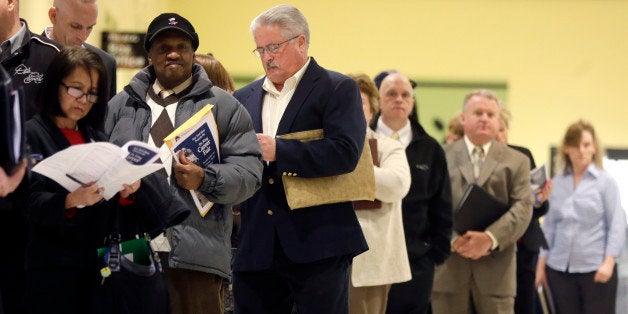
Payroll growth was strong and broad based last month and the jobless rate fell sharply, but that seemingly impressive decline in unemployment was wholly due to the shrinking labor force. In other words, a confusing month of labor market data as the two surveys reported on today tell very different stories.
The survey of establishments recorded strong payroll gains in April of 288,000, above the expected addition of 215,000. The household survey reported that the unemployment rate fell by 0.4 tenths, to 6.3 percent. That's the largest monthly decline since December 2010 and the lowest jobless rate since September 2008.
So, as my Grandma might have asked, what's not to like?
It's this: the decline in unemployment is entirely due not to job creation, but to labor force decline (employment actually fell slightly in the household survey). This important and closely watched indicator -- the labor force participation rate -- also fell 0.4 tenths, reversing recent gains and returning the lfpr to its low where it stood at the end of last year, commensurate with levels we haven't seen since the late 1970s. Though part of the recent decline in the participation rate reflects our aging demographics, more than half in my judgment is due to weak demand .
The BLS noted that the large decline in the labor force -- about -800,000 -- was likely due to fewer entrants as opposed to more leavers. And this is a volatile number, as I stress below. But neither can it be dismissed out of hand: it has been essentially stuck at historically low levels for a while now.
On the other hand, the payroll report shows pretty decent labor demand/job creation. As noted, the 288,000 jobs beat expectations, and gains for the prior two months were revised up by 36,000. Job gains occurred across most industries, with 67 percent of private industries expanding employment, the largest share in over two years (government employment was also up 15,000, almost all due to local government; federal employment was down slightly).
As I noted yesterday, you've really got to smooth these payroll gains out to get a more reliable read on the monthly employment changes.
Average change in jobs over the past:
3 months: 238,000
6 months: 203,000
12 months: 197,000
So by this metric we're wiggling around a trend of 200,000 per month, a decent and solid, if not stellar trend, though one that should be strong enough to lower the unemployment rate for the right reasons: not by shrinking the labor force but by offering more employment opportunities to all comers.
A few other notable indicators, and more to come later in the day:
-Long-term unemployment as a share of the labor force fell from 2.4 to 2.2 percent, the lowest it's been since early 2009, though still highly elevated in historical terms.
-Both hourly wage growth and weekly hours were flat over the month, and these measures come from the more positive establishment survey. Over the past year, average hourly pay is up 1.9 percent, slightly ahead of recent inflation readings, which have tracked around 1.5 percent.
Summing up, when I see a positive payroll report and negative household report, I tend to give more weight to the payroll survey, which has a much larger sample, smaller confidence intervals around its monthly estimates, and less volatile monthly jumps. So I'd call this a positive report, but with a big, nervous-making asterisk.
This post originally appeared at Jared Bernstein's On The Economy blog.
